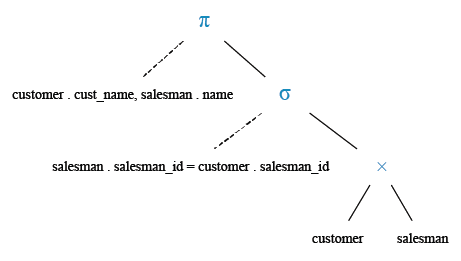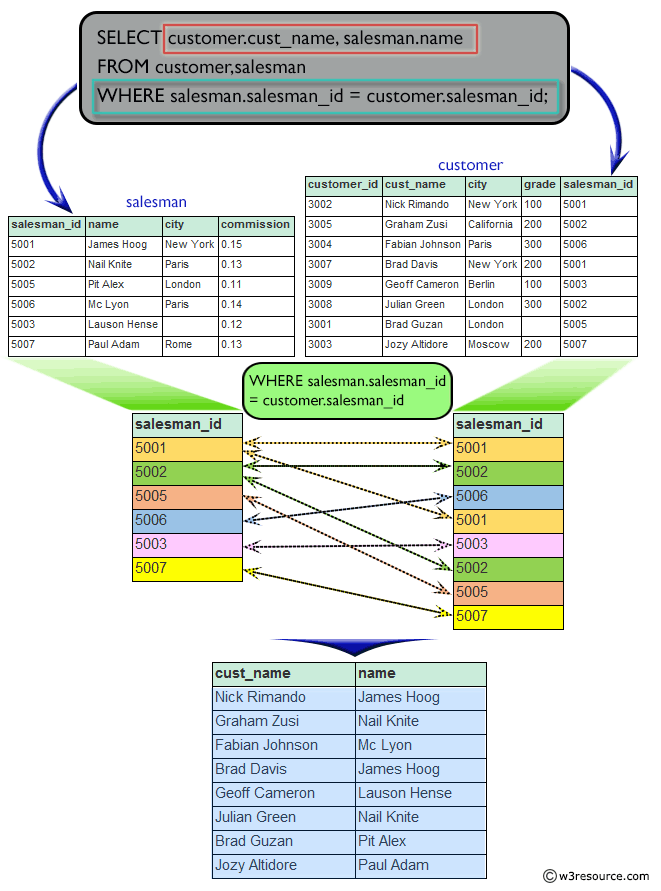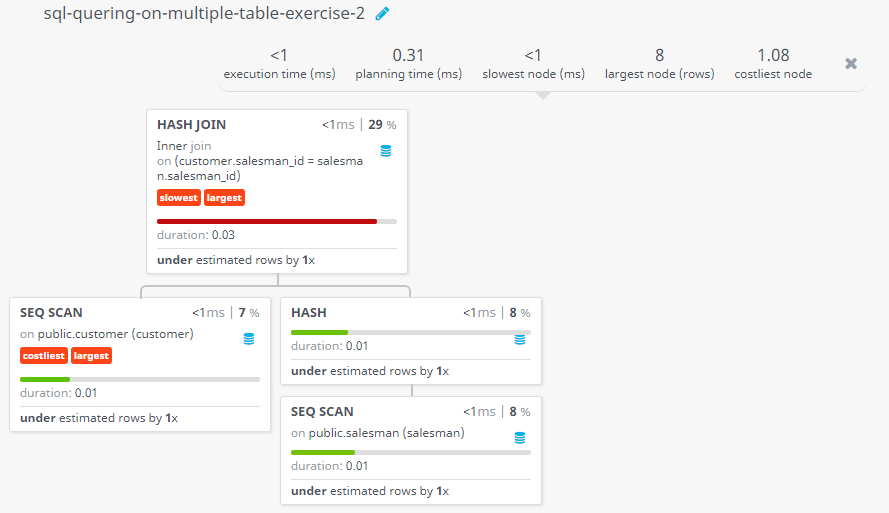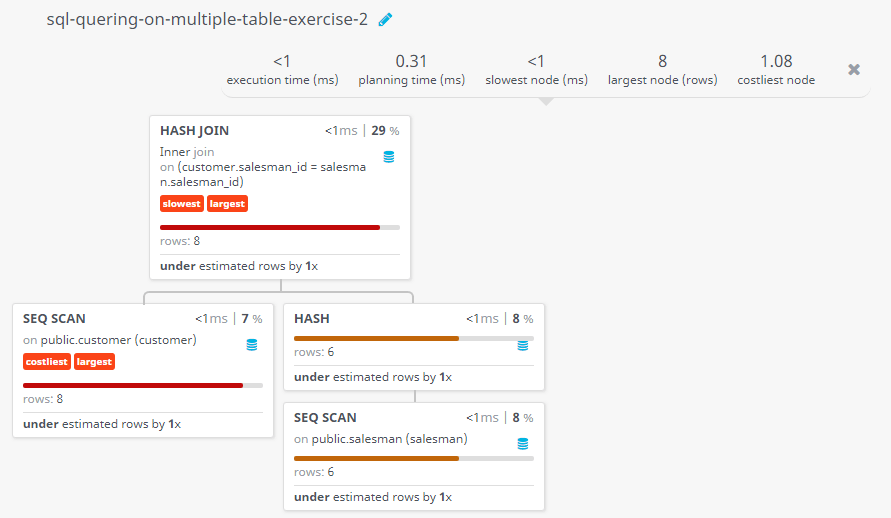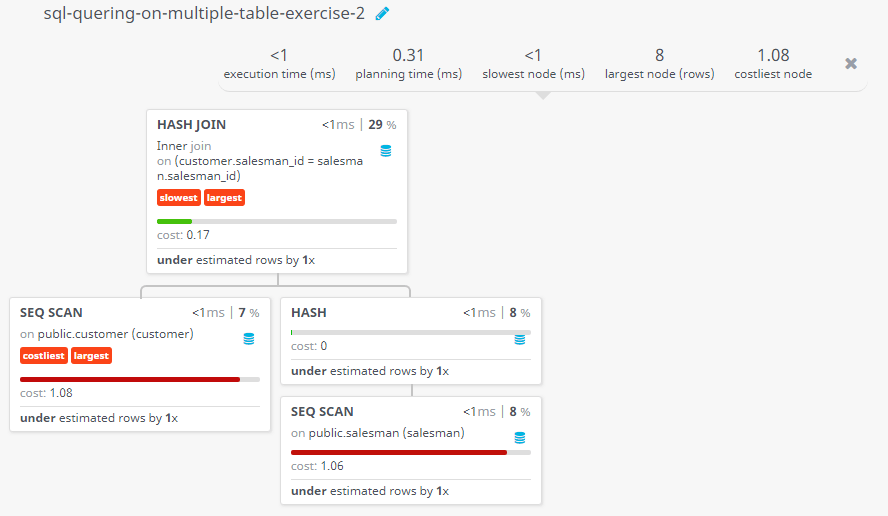SQL Exercises: Customers along with the salesmen who works for them
Customer-Salesperson Association
From the following tables, write a SQL query to locate all the customers and the salesperson who works for them. Return customer name, and salesperson name.
Sample table: customer
customer_id | cust_name | city | grade | salesman_id
-------------+----------------+------------+-------+-------------
3002 | Nick Rimando | New York | 100 | 5001
3007 | Brad Davis | New York | 200 | 5001
3005 | Graham Zusi | California | 200 | 5002
3008 | Julian Green | London | 300 | 5002
3004 | Fabian Johnson | Paris | 300 | 5006
3009 | Geoff Cameron | Berlin | 100 | 5003
3003 | Jozy Altidor | Moscow | 200 | 5007
3001 | Brad Guzan | London | | 5005
Sample table: salesman
salesman_id | name | city | commission
-------------+------------+----------+------------
5001 | James Hoog | New York | 0.15
5002 | Nail Knite | Paris | 0.13
5005 | Pit Alex | London | 0.11
5006 | Mc Lyon | Paris | 0.14
5007 | Paul Adam | Rome | 0.13
5003 | Lauson Hen | San Jose | 0.12
Sample Solution:
-- This query selects specific columns ('customer.cust_name' and 'salesman.name') from the 'customer' and 'salesman' tables.
-- It retrieves data where the 'salesman_id' column in the 'salesman' table matches the 'salesman_id' column in the 'customer' table.
SELECT customer.cust_name, salesman.name
-- Specifies the tables from which to retrieve the data (in this case, 'customer' and 'salesman').
FROM customer, salesman
-- Specifies the condition for joining the 'customer' and 'salesman' tables based on the equality of the 'salesman_id' columns.
WHERE salesman.salesman_id = customer.salesman_id;
Output of the query:
cust_name name Nick Rimando James Hoog Brad Davis James Hoog Graham Zusi Nail Knite Julian Green Nail Knite Fabian Johnson Mc Lyon Geoff Cameron Lauson Hen Jozy Altidor Paul Adam Brad Guzan Pit Alex
Code Explanation:
The given query in SQL that joins the 'customer' and 'salesman' tables based on the "salesman_id" column. The result set includes the customer name (cust_name) and salesman name (name). The WHERE clause specifies the join condition between the two tables, which is that the "salesman_id" column must be equal in both tables.
Relational Algebra Expression:
Relational Algebra Tree:
Explanation:
Visual presentation:
Go to:
PREV :Sales & City Matching.
NEXT :Different City Orders.
Practice Online
Query Visualization:
Duration:
Rows:
Cost:
For more Practice: Solve these Related Problems:
- Write a SQL query to display all customers with their assigned salespeople, including customers with no salesperson (showing NULL) using an outer join.
- Write a SQL query to list customers and their salespeople where both names start with the same letter.
- Write a SQL query to retrieve customer names and salesperson names, sorted alphabetically by customer names, while eliminating duplicate pairs.
- Write a SQL query to show customer and salesperson pairs, but only include those pairs where the salesperson’s commission exceeds 0.12.
- Write a SQL query to display customer names alongside their salesperson names, replacing missing salesperson names with the string 'Not Assigned'.
Have another way to solve this solution? Contribute your code (and comments) through Disqus.
What is the difficulty level of this exercise?
Test your Programming skills with w3resource's quiz.


